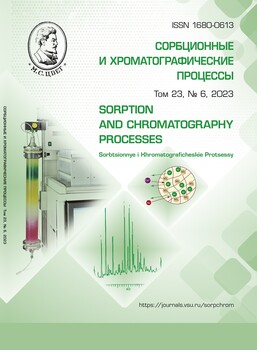Detection of the ability to dissimilate sulfate reduction in representatives of colorless sulfur bacteria of the genus Thiothrix using RNA isolated by sorption
Abstract
For the first time, the ability to anaerobic respiration using thiosulfate as a terminal electron acceptor was discovered for representatives of filamentous colorless sulfur bacteria of the genus Thiothrix, such as T. litoralis AST, T. unzii A1T and T. nivea JP2T. Previously, the ability to lithotrophic growth in the presence of thiosulfate as an electron donor for energy metabolism was shown for these bacteria.
To establish the mechanism of thiosulfate reduction during anaerobic growth, the participation of thiosulfate reductase or the disproportionation of thiosulfate, an analysis of the end products of its transformation was carried out. In all studied representatives of the genus Thiothrix, products formed during the conversion of thiosulfate, sulfite and sulfide, characteristic of the functioning of thiosulfate reductase, were identified, whereas products characteristic of the process of thiosulfate disproportionation (sulfate and sulfide) were not identified.
During the study, the genes phsA, phsB and phsC encoding thiosulfate reductase (quinone, EC 1.8.5.5) were identified, and the expression of these genes under anaerobic conditions was shown. It was found that during anaerobic growth on thiosulfate, compared with aerobic cultivation, the expression of the phsA, phsB, phsC genes in T. litoralis AST, T. unzii A1T and T. nivea JP2T in the first passage increases by 6-15 times, whereas in the second passage in T. unzii A1T there is a multiple increase in gene expression on average by 180 time. Sorbing columns were used to extract the total RNA. The samples were homogenized and lysed in the presence of a chaotropic salt, and then applied to a spin column, washed from contamination. DNA impurities were removed and pure RNA was obtained by subjecting the sample to DNAse treatment directly on the spin column. The RNA quality was assessed by electrophoresis of at least 2% agarose gel with the addition of 2.2 M formaldehyde solution.
In hydrogen sulfide biotopes, where anaerobic conditions are sporadically created, representatives of the genus Thiothrix, leading an attached lifestyle, need to switch from aerobic to anaerobic respiration to survive in dramatically changing conditions. The low yield of T. litoralis AST, T. unzii A1T and T. nivea JP2T cells
(15 mg/dm3) during anaerobic growth on thiosulfate indicates that the process of anaerobic respiration on thiosulfate has the character of a supportive metabolism.
The data obtained allow us to approach the solution of how lithotrophic sulfur bacteria of the genus Thiothrix, leading an attached lifestyle, effectively use thiosulfate in their metabolic strategy, adapting to changing environmental conditions, and explain their dominant position in flowing hydrogen sulfide biotopes.
Downloads
References
Aketagawa J., Kobayashi K., Ishimoto M., Purification and properties of thiosulfate reductase from Desulfovibrio vulgaris, J. Bio-chem., 1985; 97 (4): 1025-1032. https://doi.org/10.1093/oxfordjournals.jbchem.a135144.
Kuznetsov S.I., Dubinina G.A., Meth-ods of investigation of aqueous microorgan-isms, Nauka., 1989; 285. (In Russ.)
Ravin N.V., Rudenko T.S., Smolyakov D.D., Beletsky A.V., Gureeva M.V., Samylina O.S., Grabovich M.Y., History of the study of the genus Thiothrix: from the first enrichment cultures to pangenomic analysis, Int. J. Mol. Sci., 2022; 23(17): 9531. https://doi.org/10.3390/ijms23179531
Grabovich, M.Y., Ravin, N.V., Boden, R. Thiothrix. In Bergey’s Manual of Systemat-ics of Archaea and Bacteria; John Wiley & Sons, Inc.: Hoboken, NJ, USA, 2023; 21. https://doi.org/10.1002/9781118960608.gbm01229.pub2
Armbruster E.H., Improved technique for isolation and identification of Sphaerotilus, Appl. Microbiol., 1969; 17(2): 320-321. https://doi.org/10.1128/am.17.2.320-321.1969
Lippert K.D., Pfennig N., Die Verwer-tung von molekularem wasserstoff durch chlo-robium thiosulfatophilum. wachstum und CO2-fixierung [Utilisation of molecular hydrogen by Chlorobium thiosulfatophilum. Growth and CO2-fixation], Arch. Mikrobiol., 1969; 65: 29-47. (In Russ.)
Winogradsky, S. Beiträge zur mor-phologie und physiologie der bacterien. In Heft I. Zur Morphologie UND Physiologie Der Schwefelbacterien; Arthur Felix: Leipzig, Ger-many, 1888: 1-120.
Larkin J.M., Strohl W.R., Beggiatoa, Thiothrix, and Thioploca, Microbiol. Annual. Review of Microbiology., 1983; 37: 341-367. https://doi.org/10.1146/annurev.mi.37.100183.002013
Rudenko T.S., Orlova M.V., Slepchen-ko A.V., Shatskiy N.D., Smoliakov D.D., Grabovich M.Y., Methylotrophy in Azospiril-lum thiophilum BV-S, Sorbtsionnye I Khroma-tograficheskie Protsessy, 2018; 18(3): 438-442. https://doi.org/10.17308/sorpchrom.2018.18/549 (In Russ.)
Hammer M., Mark J. Water and Waste-Water Technology. New York: John Wiley & Sons, Incorporated. 1974. 502 p.
Myers J.E., Farhat D., Guzman A., Ar-ya V., Myers et al. Respond, Am. J. Public Health, 2019; 109(11): 21-22. https://doi.org/10.2105/AJPH.2019.305323
Lowry O.H., Rosebrough N.J., Farr A.L., Randall R.J., Protein measurement with the Folin phenol reagent, J. Biol. Chem., 1951; 193(1): 265-75
Brettin T., Davis J.J., Disz T., Edwards R.A., Gerdes S., Olsen G.J., Olson R., Over-beek R., Parrello B., Pusch G.D., Shukla M., Thomason J.A. 3rd, Stevens R., Vonstein V., Wattam A.R., Xia F., RASTtk: a modular and extensible implementation of the RAST algo-rithm for building custom annotation pipelines and annotating batches of genomes, Sci. Rep., 2015; 10: 8365. https://doi.org/10.1038/srep08365
Tamura K., Stecher G., Kumar S., MEGA11: Molecular Evolutionary Genetics Analysis Version 11, Mol. Biol. Evol., 2021; 38(7): 3022-3027. https://doi.org/10.1093/molbev/msab120
Haschke R.H., Campbell L.L., Thiosul-fate reductase of Desulfovibrio vulgaris, Bacte-riol., 1971; 106(2): 603-607. https://doi.org/10.1128/jb.106.2.603-607.1971
Haja D.K., Wu C.H., Poole F.L. 2nd, Sugar J, Williams S.G., Jones A.K., Adams M.W.W., Characterization of thiosulfate reduc-tase from Pyrobaculum aerophilum heterolo-gously produced in Pyrococcus furiosus, Ex-tremophiles, 2020; 24: 53-62. https://doi.org/10.1007/s00792-019-01112-9
Chauncey T.R., Uhteg L.C., Westley J., Thiosulfate reductase, Methods Enzymol., 1987; 143: 350-354. https://doi.org/
1016/0076-6879(87)43062-0
Bang S.W., Clark D.S., Keasling J.D., Engineering hydrogen sulfide production and cadmium removal by expression of the thiosul-fate reductase gene (phsABC) from Salmonella enterica serovar typhimurium in Escherichia coli, Appl. Environ. Microbiol., 2000; 66(9): 39-44. https://doi.org/10.1128/AEM.66.9.3939-3944.2000
Kramer M., Cypionka H., Sulfate for-mation via ATP sulfurylase in thiosulfate- and sulfite-disproportionating bacteria, Arch. Mi-crobiol., 1989; 151: 232-237. https://doi.org/10.1007/BF00413135
Saitou N., Nei M., The neighbor-joining method: a new method for reconstruct-ing phylogenetic trees, Mol. Biol. Evol., 1987; 4(4): 406-425. https://doi.org/10.1093/oxfordjournals.molbev.a040454
Felsenstein J., Confidence limits on phylogenies: an approach using the bootstrap, Evolution., 1985; 39: 783-791. https://doi.org/10.1111/j.1558-5646.1985.tb00420.x
Zuckerkandl E., Pauling L., Molecules as documents of evolutionary history, J. Theor. Biol., 1965; 8(2): 357-366. https://doi.org/10.1016/0022-5193(65)90083-4







